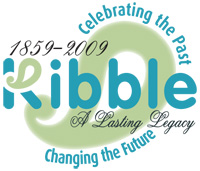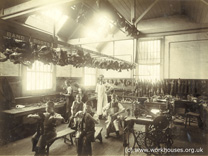themes
themes
Page 1
1 | 2 | 3 | 4
Skills Training and Social Enterprise

Introduction
Kibble provided skills training for the boys in its care from its earliest days. According to Kibble’s first full Trustees’ Report, dated April 6th 1861, at that time boys were trained in shoemaking, tailoring and gardening. A key aim from the outset was, then, not merely to punish the boys who were committed here but to help equip them with skills that would enable them to live independently when they left.

Example of a shoemaker’s workshop
Image used with permission by Peter Higginbotham www.workhouses.org.uk.
Copyright © www.workhouses.org.uk
Trades Training
The 1861 Report states that the boys of the institution had carried out all the levelling, road making, digging and trenching of the grounds, assisted by the gardener. Finding very early on that is was impossible to employ all the boys at outdoor labour and that ‘the ages of many precluded such employment’, a tailor was engaged on 1st October 1859 and a workshop was fitted up. The Trustees were ‘happy to observe that this department has been self-sustaining, the profits on the work being equal to the salary of the master’. The role of the workshop seems then to have been twofold: to present a training opportunity for the boys as well as providing an income to support the institution. For it to have been a profitable enterprise, they must have fulfilled external contracts, although we have no written records to confirm this. The tailoring workshop also seems to have provided clothing for boys when they left Kibble, and profits were used to give assistance to them on leaving: ‘In addition to the ordinary maintenance of the Institution, the Trustees have been enabled to give liberal outfits to the boys on leaving, and also to afford assistance in several cases for some time after, thus enabling them to make a fair start in life.’ These are fundamental features of social enterprise activities. Evidence suggests that the focus of the tailor shop was not limited to practical aspects of the work. A 1915 entry in the minute books of the Industrial Committee notes that lessons had been given to tailor shop trainees in ‘how to conduct a business’.
The shoemaker’s workshop was the next one to be installed and a master was engaged on 7th September 1860, ‘with a similar object in view’. According to the Trustees’ Report, It was not yet turning a profit in 1861: ‘Owing to the short period during which this has been in operation, and the boys being as yet only learning, the profits are not yet so satisfactory as on the tailoring department, but there is every reason to anticipate that in course of time the results will be equally successful.’ Later records show that was indeed the case, with references in 1907 to a contract to supply the Poorhouse with boots. As part of their training, in 1910 the boys working in the shoemaker’s shop were also shown round Mr Fred Lang’s tannery and given an explanation of all the processes.
The motivations behind these operations are revealed in the 1861 Report: ‘The object contemplated is the entire occupation of the day, under the eye of the Master, in a well-arranged division of education, industrial training, and recreation; and looking at the impressible age of the boys, the length of time they are subjected to training, and the moral influence which the constant surveillance of the master cannot fail to exert over them, there is every reason to hope that the Institution may with the Divine blessing, be instrumental in rescuing nearly all those young persons from a life of crime, and restoring them to society as useful citizens.’
It is worth noting that the tone of the language emphasises criminality and a justice-based approach, consistent with attitudes at the time, as the period 1854-1885 was known as the “Reformatory Era”. A similar focus is evident in the Report with regard to aftercare, as well as very early references to assisted emigration:
‘One of the greatest difficulties connected with the reclamation of the criminal population (emphasis added) has been the disposal of them after leaving either a Prison or Reformatory. Without a helping hand being extended to those unfortunates, they are often compelled to resort to their former haunts and associates. The Trustees therefore contemplate the application of a portion of the funds at their disposal to meet this difficulty, by assisting those leaving the Institution to emigrate, or aiding them for a time until they are able to support themselves by their own exertions.’
